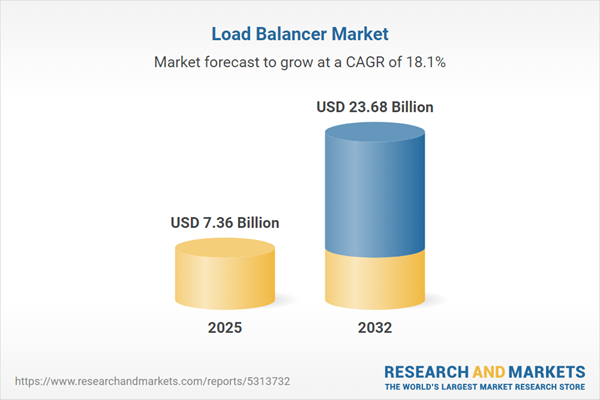Speak directly to the analyst to clarify any post sales queries you may have.
Enterprises focused on digital transformation are navigating increasingly complex compliance and operational demands. The global load balancer market enables organizations to strengthen IT infrastructures, ensuring security, flexibility, and readiness for future technology shifts or new regulatory requirements.
Market Snapshot: Global Load Balancer Market Size & Growth Dynamics
The global load balancer market stands at USD 6.24 billion, with projections reaching USD 7.36 billion in a single year and estimates showing expansion to USD 23.68 billion by 2032, driven by a compound annual growth rate (CAGR) of 18.13%. This notable growth stems from accelerated adoption of cloud technologies and a broad shift toward digital-first operating models. Senior leaders are recognizing the value of advanced load balancing within IT modernization, as it enables sustained business continuity, facilitates compliance alignment, and supports scalable infrastructure development within rapidly evolving enterprise environments.
Scope & Segmentation: Insights for Strategic Decision-Makers
This report provides actionable market segmentation for executives seeking optimal investment strategies and technology direction. The structure facilitates alignment of resources with ROI-focused digital transformation initiatives. Major segmentation areas include:
- End User Industry: Financial services, healthcare, life sciences, government, IT and telecom, manufacturing, retail, and ecommerce all require custom load balancing solutions to address regulations, data sensitivity, and application uptime.
- Deployment Models: Cloud-based, hybrid, and on-premises options provide flexible degrees of control, allowing organizations to tailor approaches based on operational complexity and compliance needs.
- Type: Local and global server load balancing technologies help enterprises optimize application delivery with regional or worldwide reach, enhancing response times and high availability.
- Organization Size: Solutions are built to accommodate large enterprises seeking integration with legacy systems as well as small to medium-sized businesses requiring straightforward adoption paths.
- Offering: The market features hardware appliances, virtual appliances, and software-driven tools, catering to legacy data centers and cloud-native or hybrid deployments.
- Geographies: Analysis covers the Americas, Europe, Middle East and Africa, and Asia-Pacific, accounting for ongoing shifts in regional regulations, security standards, and localized market drivers that influence how load balancers are adopted and managed.
Specific industries, including finance and healthcare, are raising demands for enhanced governance and full auditability, influenced by regional compliance mandates. In contrast, sectors like retail and telecom emphasize minimal downtime and user experience, encouraging vendors to deliver tailored solutions that match region-specific innovation and regulation cycles.
Key Takeaways for the Load Balancer Market
- Automation in load balancing strengthens network performance and organizational resilience, enabling rapid adaptation as IT environments become more distributed and complex.
- Advancements in edge computing and the influx of 5G foster the need for agile, responsive systems that can reduce latency and deliver efficient network operations at scale.
- Integration of network analytics and artificial intelligence elevates visibility across the infrastructure, supporting proactive troubleshooting and reinforcing security measures in multi-layered environments.
- Shifts in technology procurement point toward solutions with embedded compliance and strong data security, influencing platform selection from initial implementation to ongoing renewals.
- Hybrid and cloud-native solutions offer strategic flexibility, making it easier for organizations to adjust to regulatory changes and implement ongoing modernization in dynamic competitive landscapes.
Tariff Impact: Strategic Shifts and Supply Chain Adaptation
Recent changes to US tariffs are reshaping purchasing approaches for load balancer technology. Organizations are prioritizing software-defined and virtualized architectures to better control capital expenditures and mitigate supply chain disruptions. This evolution is fostering collaboration with local and regional partners to maintain compliance and enhance IT continuity.
Methodology & Data Sources
The market assessment utilizes secondary research, expert insights from IT professionals, and targeted enterprise surveys. This combination integrates regulatory considerations and first-hand industry perspectives to ensure a comprehensive and relevant analysis.
Why This Load Balancer Market Report Matters
- Enables benchmarking of digital transformation progress across cloud, hybrid, and edge environments, leveraging the latest industry trends and practical guidance.
- Clarifies the impact of evolving regulations on technology procurement, risk management, and planning across diverse sectors.
- Supports decision-makers in refining operational processes and building durable partnerships to deftly respond to technological and regulatory challenges.
Conclusion
This analysis provides executives with focused intelligence to align load balancing strategies to enterprise goals. By integrating compliance, resilience, and performance, leaders can confidently plan IT investments that advance organizational priorities.
Additional Product Information:
- Purchase of this report includes 1 year online access with quarterly updates.
- This report can be updated on request. Please contact our Customer Experience team using the Ask a Question widget on our website.
Table of Contents
3. Executive Summary
4. Market Overview
7. Cumulative Impact of Artificial Intelligence 2025
Companies Mentioned
The companies profiled in this Load Balancer market report include:- F5 Networks, Inc.
- Citrix Systems, Inc.
- Cisco Systems, Inc.
- Radware Ltd.
- A10 Networks, Inc.
- Progress Software Corporation
- VMware, Inc.
- Amazon.com, Inc.
- Microsoft Corporation
- Google LLC
Table Information
| Report Attribute | Details |
|---|---|
| No. of Pages | 198 |
| Published | November 2025 |
| Forecast Period | 2025 - 2032 |
| Estimated Market Value ( USD | $ 7.36 Billion |
| Forecasted Market Value ( USD | $ 23.68 Billion |
| Compound Annual Growth Rate | 18.1% |
| Regions Covered | Global |
| No. of Companies Mentioned | 11 |









